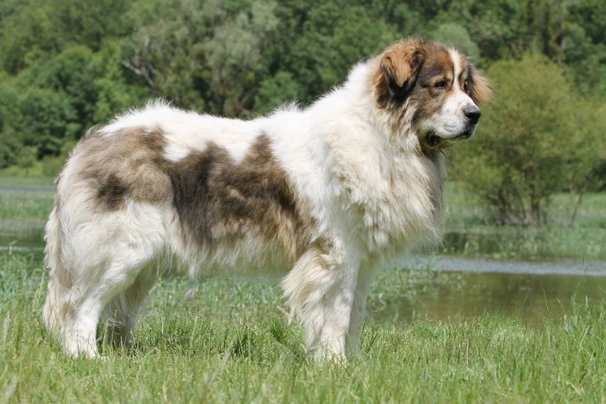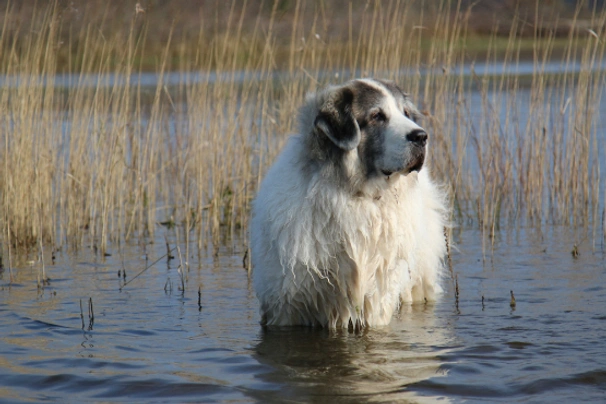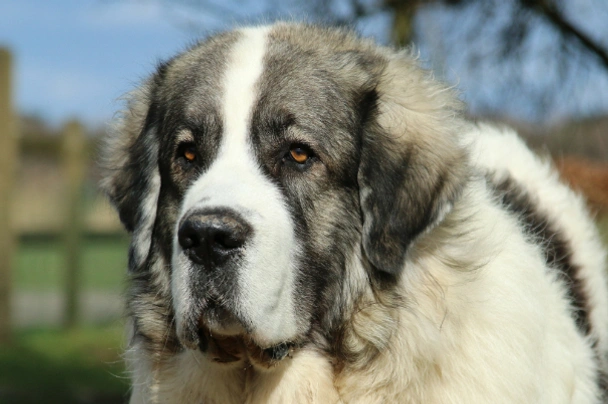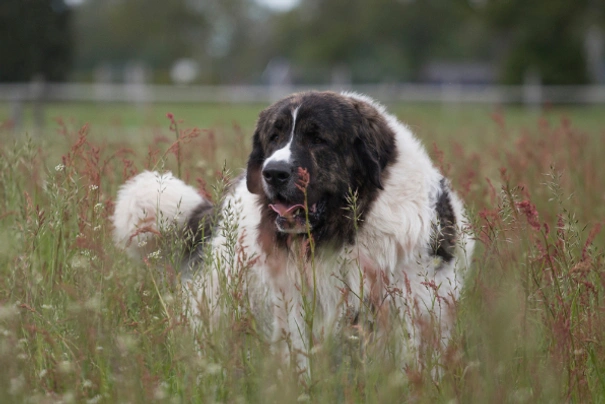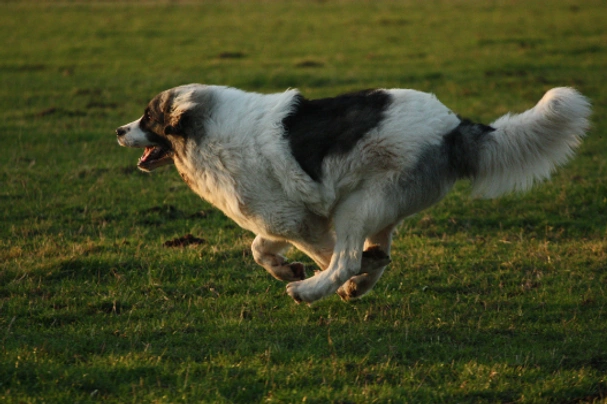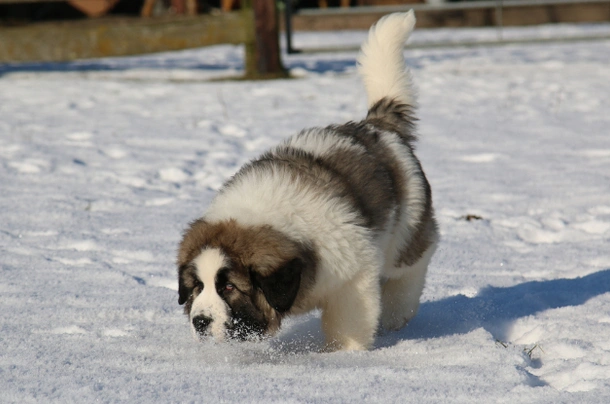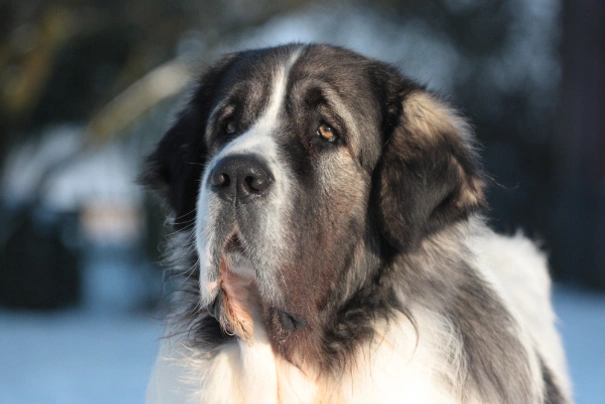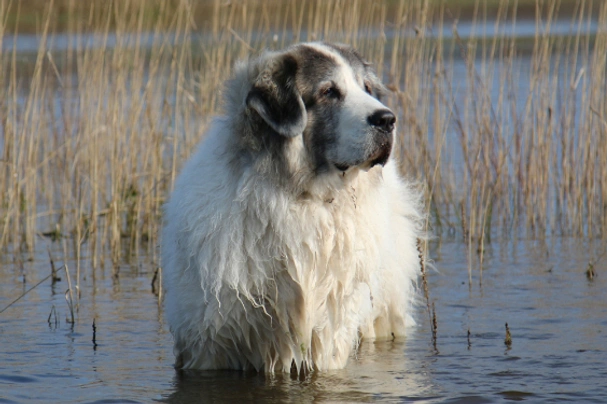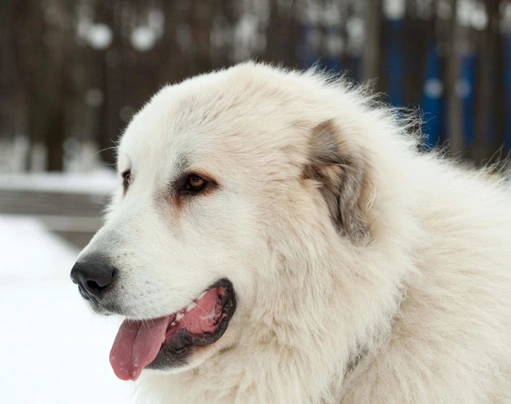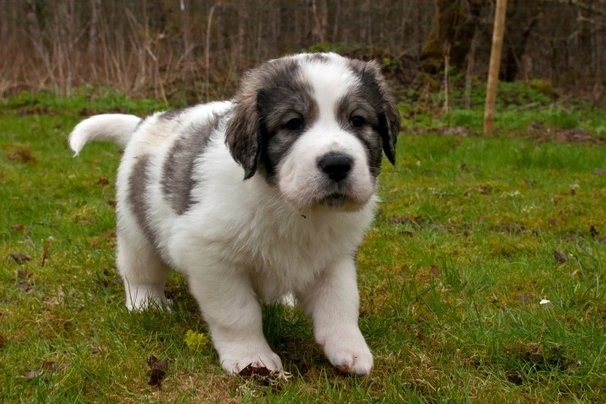Pyrenean Mastiff
Pros
Cons
Introduction of the Pyrenean Mastiff
The Pyrenean Mastiff stands out as a magnificent giant among dog breeds, renowned for its imposing size, dense double coat, and striking ruff of longer hair around the neck. This breed encapsulates the essence of a gentle giant, forming profound and loyal bonds with their human family members. Its historical role as a guardian of livestock in the mountainous regions of Spain has evolved into a modern companion dog that thrives on involvement and companionship within the home environment.
Originally bred to protect flocks from predators such as wolves and bears, the Pyrenean Mastiff exhibits a natural guarding instinct combined with a calm and steady temperament. Despite their size and strength, they move with surprising lightness and agility for a dog of their stature, reflecting their working heritage. Their temperament is generally confident yet independent, requiring owners who appreciate a breed with both strength and sensitivity.
Ideal owners are those with experience handling large, powerful breeds and who can provide ample space, ideally a rural or suburban home with a secure large garden, where the dog can roam freely. They suit active families who can commit to consistent training and socialisation from puppyhood. While they enjoy time outdoors, they equally cherish close family contact, making regular involvement in family life essential for their wellbeing.
Caring for a Pyrenean Mastiff involves meeting their physical needs through daily exercise and mental stimulation, plus maintaining their thick double coat with regular grooming. Their coat requires diligence particularly during shedding seasons, while their protective instincts mean early, ongoing socialisation and training are crucial. Potential owners must be prepared for the responsibilities of managing a large, powerful, and highly intelligent breed to ensure a harmonious life partnership.
Perfect For
Active families or individuals experienced with large breeds who have the space to accommodate a giant dog. Those wanting a loyal, protective companion who relishes involvement in family activities and can provide firm, consistent guidance.
Key Considerations
Requires a secure large garden and sufficient exercise to remain balanced. Not suited for apartment living. Early socialisation and consistent, positive training are vital to manage their independent and protective nature. Potential health concerns include hip dysplasia and risk of bloat that must be monitored.
History of the Pyrenean Mastiff
The Pyrenean Mastiff's roots trace back centuries to the mountainous borderlands of Spain, specifically between the regions of Aragon and Navarra. In the Middle Ages, the breed emerged distinct from the Spanish Mastiff of Castilla, adapted to the environmental needs of the Pyrenees' southern slopes. These dogs were bred primarily as guardian protectors, defending livestock from formidable predators such as wolves and bears, showcasing courage and resilience vital for survival in a rugged landscape.
Early Development
The breed descends from ancient molossoid dogs introduced to the Iberian Peninsula by Phoenician traders from Sumeria and Assyria. Over generations, selective breeding by local shepherds refined these dogs for endurance, protective instincts, and strong physical attributes, necessary for the harsh conditions and threats of mountainous terrain. Known historically as the Navarra or Aragon Mastiff, they served as indispensable livestock guardians, valued for both strength and gentleness with the flocks entrusted to their care.
Modern Recognition
The Pyrenean Mastiff experienced fluctuating fortunes in the 20th century, with numbers declining post-Spanish Civil War and the eradication of wolves. Renewed breed interest in the 1970s, led by dedicated enthusiasts—aided by official founding clubs like the Club del Mastín del Pirineo de España in 1977—helped rescue the breed from near extinction. Recognition by the Fédération Cynologique Internationale followed in 1982, with the UK's Kennel Club acknowledging the breed more recently; however, an official UK breed standard remains to be established. Despite its rarity outside Spain, the Pyrenean Mastiff endures as a respected and treasured guardian breed.
Appearance of the Pyrenean Mastiff
Size and Build
The Pyrenean Mastiff is a giant breed, with males standing between 76.2 and 81.28 cm at the withers and females slightly smaller, ranging from 74.93 to 81.28 cm. Both sexes weigh impressively between 81 and 100 kg. They feature a well-balanced, powerful yet agile physique that avoids any impression of heaviness or sluggishness, attributed to their supple bodies and strong sinews. Length exceeds height slightly, with a deep, broad chest and well-sprung ribs providing breath capacity essential for endurance. Males often exhibit more pronounced masculinity in musculature and bone density.
Coat and Colours
The coat of the Pyrenean Mastiff is a thick, dense double coat, characterized by a harsher outer topcoat and a soft, insulating undercoat. The neck, shoulders, belly, back of legs, and tail boast longer hair, with the tail's underside forming a distinctive plume. Accepted colours include grey and white, as well as a tri-colour combination of white, grey, and sand. Their facial mask is distinct, ears are spotted, and tails and lower legs feature white markings. Seasonal shedding peaks in spring and autumn require more frequent grooming to keep the coat in optimal condition.
Distinctive Features
The head is large and strong, with a skull slightly longer than the muzzle, a slight stop, and a pronounced occipital bone. The jaws are powerful with a perfect scissor bite, complemented by a broad black nose. Almond-shaped eyes are dark, though hazel tones are acceptable, always conveying alertness and kindness. Ears are moderate in size, triangular, set above eye line, hanging close when relaxed, but flicking out when alert. The neck features a pronounced dewlap and loose skin. Legs are straight and sinewy, ending in cat-like feet with slight oval shape to the hind feet. The tail, thick at the base and curling into a scimitar shape when alert, is a unique trademark. Their gait is purposeful, powerful, and straight, exhibiting light-footedness despite their size.
Gender Differences
Males tend to be slightly larger with more substantial musculature, while females show a slightly lighter frame but equal height range. Temperamentally, females may exhibit slightly more reserved behaviour, but both sexes share the breed’s signature gentle and protective nature. The presence of double dewclaws varies individually and is not a primary breed distinction.
Temperament of the Pyrenean Mastiff
Core Personality Traits
The Pyrenean Mastiff is famously a gentle giant, embodying loyalty, protectiveness, and intelligence. They form deep attachments to their families, displaying affection and a calm demeanor within the home. Their guarding instincts are strong but controlled; they are naturally wary of strangers without undue aggression, relying on presence and alertness to deter threats. This breed values knowing their place within the household pack hierarchy, thriving under clear leadership.
Social Behavior
While reserved around unfamiliar people, Pyrenean Mastiffs often warm up with time and positive socialisation. They generally coexist well with other dogs when socialised young, though they may stand their ground if feeling threatened. Interactions with smaller animals require caution due to their instinct to protect and potential chase instincts. Around children, they are affectionate and playful, but their large size necessitates supervision, especially with younger youngsters.
Working Instincts
The breed retains strong livestock guardian instincts, naturally alert and protective without aggressive tendencies. They possess an inherent drive to guard property and family, often responding to perceived threats with quiet vigilance. Their playfulness, especially in youth, balances their serious work heritage, making them lively yet composed companions.
Common Behavioral Challenges
Potential challenges include a tendency toward dominance if leadership is unclear, which may lead to stubbornness. Their protective nature can cause suspicion of strangers and require careful management to avoid territorial behaviours turning negative. Separation anxiety may develop if left alone for extended periods, manifesting in destructive behaviours. Early and ongoing training focusing on socialisation and boundaries is essential to minimise these issues.
Intelligence / Trainability of the Pyrenean Mastiff
The Pyrenean Mastiff is Intelligent and eager to please when trained with patience and positive reinforcement, making them generally trainable but requiring consistent leadership. Their natural independence means training is most successful when it is fair and engaging, avoiding harsh corrections which can damage their sensitive nature.
Puppy Training Priorities
Early socialisation and foundation obedience commands—such as sit, stay, come, heel, and leave it—are crucial to establish trust and direction. Puppies should be exposed gradually to diverse environments, sounds, people, and other animals following vaccinations. Establishing a household pecking order early ensures the dog understands its role, mitigating dominance tendencies.
Training Methods That Work
Positive reinforcement with high-value treats and praise works best, combined with short, interactive sessions to maintain interest. Consistency in rules and commands aids comprehension. Use fun, varied tasks to prevent boredom, enhancing engagement and focus. Avoid overly repetitive or punishment-based approaches, as these reduce motivation.
Advanced Training Potential
Pyrenean Mastiffs can excel in disciplines like obedience, agility, and flyball, especially when motivated by owner interaction and rewarding activities. While they may be slower learners than some breeds due to independence, their intelligence allows them to perform complex tasks with patient guidance.
Common Training Mistakes
Frequent errors include inconsistent leadership, allowing dominance to develop, and expecting rapid results without patience. Over-exercising puppies can harm developing joints, so training with physical tasks must be carefully balanced. Neglecting socialisation risks territorial aggression. Owners should also avoid harsh corrections that may undermine confidence.
Children and other
Age-Specific Interactions
Pyrenean Mastiffs generally interact best with older children who understand how to respect their considerable size and strength. Due to their large stature, they are not recommended for households with toddlers or very young children as accidental knocks or scares can easily occur.
Teaching Children Proper Interaction
Parents should educate children on how to approach and behave around the dog, emphasising gentle touch and respecting the dog's space during feeding or resting. Clear rules should be established to prevent unintentional provocation, helping ensure positive and safe interactions.
Breed-Specific Considerations
The breed's size means that supervision is crucial during play, especially with younger children. Their protective instincts mean they may be wary of strangers, so gradual introductions and socialisation are necessary when children have visitors. Their patience with children is generally good, but owners must be alert to signs of stress or discomfort.
Creating Safe Environments
Children and dogs should never be left unattended together. Creating safe zones where the Pyrenean Mastiff can retreat is important to reduce stress and provide rest. Properly fenced gardens help ensure both child and dog safety during outdoor play. Consistent supervision is the key to a harmonious family dynamic involving this giant breed.
Health of the Pyrenean Mastiff
Breed-Specific Health Conditions
The Pyrenean Mastiff typically enjoys good health for a giant breed, but owners must be vigilant for several hereditary and common large-breed health issues. Hip dysplasia and elbow dysplasia are primary concerns, necessitating screening through the British Veterinary Association (BVA) schemes.
Eye conditions such as entropion, ectropion, glaucoma, and cataracts also occur in the breed and are screened by specialist eye testing under the BVA/Kennel Club Eye Scheme. Other health problems include hypothyroidism, inflammatory bowel disease (IBD), arthritis, intervertebral disc disease (IVDD), and the risk of bloat (gastric torsion), which can be life-threatening without prompt intervention.
Genetic Testing Requirements
Responsible breeders actively use the BVA/KC hip and elbow dysplasia schemes alongside the BVA/ISDS eye schemes to identify clear health status before breeding. Additionally, genetic testing for degenerative myelopathy is recommended due to its impact on mobility and quality of life.
Preventive Healthcare Schedule
Puppies receive initial vaccinations prior to sale. Follow-up vaccinations typically occur at 10-12 weeks, with boosters recommended throughout life; however, consultation with a veterinary professional is advised regarding the necessity of annual boosters. Regular health checks and weight management help prevent obesity-related complications.
Insurance Considerations
Insurance premiums reflect the breed’s size and potential for hereditary conditions, requiring owners to consider coverage carefully. Lifelong policies mitigate high-cost treatments typical for large breeds. Common claims often relate to joint health, bloat, and eye conditions.
Caring for the Pyrenean Mastiff
Maintaining a Pyrenean Mastiff’s wellbeing involves a blend of dedicated grooming, appropriate exercise, nutritional care, and attentive health monitoring. Their thick double coat, while not demanding intricate grooming, benefits from regular brushing two to three times weekly to remove loose hairs and prevent matting, especially during shedding seasons in spring and autumn.
Daily Care Routine
A typical day should start with a shorter walk, followed by a longer afternoon exercise allowing off-lead exploration in a secure environment. Mental enrichment through interaction and training is equally important. Feeding should be consistent, with measured meals spaced through the day to prevent bloat.
Living Environment Needs
Due to their large size, Pyrenean Mastiffs require spacious homes ideally situated in rural or suburban settings with securely fenced large gardens for roaming. Urban apartments are unsuitable, as confinement can lead to behavioural issues. Climate considerations include protection from extreme heat and thorough drying post-exposure to moisture to prevent skin problems.
Seasonal Care Adjustments
During summer, ensure ample shade, fresh water, and avoid vigorous exercise during peak heat. In colder months, their dense coat offers good insulation, but older dogs may require supplementary bedding or shelter adjustments to maintain comfort.
Senior Care Adaptations
Older dogs benefit from softer surfaces, dietary adjustments to maintain healthy weight, joint supplements, and reduced exercise intensity to accommodate arthritis and mobility challenges. Regular vet monitoring supports quality of life.
Grooming of the Pyrenean Mastiff
Coat Maintenance Schedule
The Pyrenean Mastiff’s thick double coat requires brushing approximately two to three times weekly to manage shedding and preserve skin health. During seasonal molts in spring and autumn, daily brushing may be necessary to handle increased hair loss and prevent matting.
Professional Grooming Requirements
Although generally low maintenance compared to breeds with more complex grooming demands, occasional visits to a professional groomer for ear cleaning, nail trimming, and coat checks are advisable. Grooming costs typically align with routine large-breed maintenance, no specialised clipping is generally required.
Home Grooming Techniques
Owners should use a slicker brush for the outer coat and a grooming glove to manage shedding. Regular ear inspections and gentle cleanings with vet-approved products help prevent infection. Nail trimming with appropriate clippers should be done every few weeks, with safety scissors used for minor trimming around sensitive areas.
Common Grooming Challenges
Careful attention is needed to avoid moisture retention in the dense coat after swimming or wet weather, to reduce skin irritation or infections. Excessive shedding during transitional seasons demands patience and diligence to prevent house hair buildup.
Exercise of the Pyrenean Mastiff
Daily Exercise Requirements
Pyrenean Mastiffs require a minimum of one hour of daily exercise, with opportunities for off-lead time in a secure area to satisfy their need to roam and explore. This amount maintains their physical health without overexertion, especially crucial for puppies and seniors.
Suitable Activities
Leisurely walks, gentle hikes, and structured play sessions support their mental and physical stimulation. Given their guardian heritage, activities that encourage alertness without high-intensity effort suit them best.
Exercise Restrictions
Puppies must avoid excessive exercise to protect growing joints. Vigorous activities, jumping, and stair climbing should be restricted until full maturity. Weather extremes also warrant exercise adjustments to prevent overheating or cold stress.
Mental Stimulation Ideas
Provide puzzle feeders, obedience training, and interactive games to challenge their intelligence. Novel environments and scent trails can engage their natural curiosity and maintain mental wellbeing.
Feeding of the Pyrenean Mastiff
Nutritional Requirements
Pyrenean Mastiffs require a diet formulated for large giant breeds, balanced with appropriate protein levels ranging from 18-25% and controlled fat between 10-15%, supporting muscle mass and overall energy needs. Puppies have higher caloric requirements that decrease in adulthood.
Feeding Schedule Guidelines
Feeding should be split into two daily meals for adults to reduce bloat risk; puppies benefit from three or four smaller meals spread throughout the day. Portion sizes should be adapted based on age, weight, and activity level, with careful monitoring to prevent obesity.
Special Dietary Considerations
Due to predisposition to bloat, slow feeding bowls or elevated feeders are advisable. Sensitive digestive systems may require diets limited in fillers and additives. Supplements like glucosamine and omega fatty acids can support joint and coat health.
Weight Management
Preventing obesity is paramount, given the breed’s size and joint stress risks. Regular weight checks and portion control, coupled with adequate exercise, help maintain an ideal body condition score throughout life stages.
Pyrenean Mastiff price
Due to the rarity of Pyrenean Mastiff puppies in the UK, prospective owners typically need to register interest with breeders and possibly join waiting lists. Well-bred, Kennel Club registered Pyrenean Mastiff puppies usually start at around £800, with prices varying based on lineage, breeder reputation, and location.
Insurance costs for a typical 3-year-old male Pyrenean Mastiff average approximately £61 per month for basic cover, rising to around £124 monthly for lifetime policies, influenced by factors such as region, age, and neutering status.
Feeding expenses for this large breed are significant, with monthly costs for high-quality diet averaging between £80 and £90, tailored to life stage and activity levels. Annual veterinary care, including vaccinations, neutering, and health checks, can exceed £1500, underscoring the importance of budgeting carefully for lifelong ownership.
Overall, monthly upkeep costs range between £130 and £210, excluding initial purchase price. Responsible ownership requires allocation for grooming, diet, exercise, vet care, and insurance. For those interested, you can find Pyrenean Mastiff for sale on Pets4Homes.
Buying advice
Locating a well-bred Pyrenean Mastiff for sale in the UK can be challenging due to their rarity and limited litters registered annually. Prospective buyers should prepare for waitlists and thoroughly vet breeders to ensure ethical practices and health testing compliance.
Finding Ethical Breeders
Seek breeders who demonstrate transparency with health clearances, allow visits to meet puppies with their mothers, and adhere to the Kennel Club's breeding regulations. Avoid breeders who require payment before viewing or those who overbreed females for profit. Verify membership in breed clubs or assurance schemes.
Health Testing Verification
Confirm that puppies come from parents tested for hip and elbow dysplasia through BVA/KC schemes, and eye conditions via BVA/ISDS eye tests. Genetic testing for conditions like degenerative myelopathy adds assurance of health commitment.
Puppy Selection Process
Observe puppies’ temperament, looking for confident, balanced individuals showing curiosity without excessive fear or aggression. Check veterinary records for vaccination, worming, and microchipping. Assess overall health and physical condition prior to commitment.
Contract and Guarantee Review
Ensure clear contracts specifying health warranties, return policies, and spay/neuter agreements. Watch for vague guarantees or conditions that transfer responsibility prematurely. A reputable breeder provides ongoing support after sale.
Rescue and Adoption Options
Given the breed's rarity, adoption options may be limited, but some specialised rescues exist. Always consider adoption as a noble option, and contact breed-specific rescues for information. Adopting an adult requires evaluation of training and health needs.
